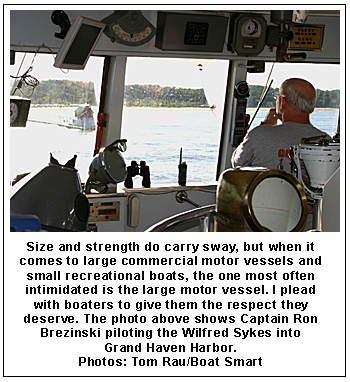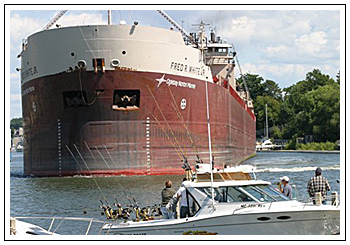|
Great Lakes Captains
Deserve Utmost Respect
by Tom Rau

While conducting research for my
book, “The Boat Smart Chronicles, Lake Michigan
Devours Its Wounded,” I rode aboard with a number of
commercial captains from large motor vessels to
captains of small passenger-carrying vessels. From
their vantage point on the bridge, I was able to
witness firsthand the ordeals and tribulations
imposed upon them by recreational
boaters—transgressions they must so often bear in
silent indignation. I think the world of these
captains: truly the Great Lakes’ consummate maritime
professionals.
Not only do these professional captains deserve
utmost respect, but more so they deserve a little
empathy from the boating public on the challenges
they face, especially while making port. Let’s go
aboard the motor vessel Wilfred Sykes to walk
a step or two in the captain’s shoes.
The steamer Wilfred Sykes is a 671-foot long
bulk carrier capable of carrying 21,550 tons of
cargo in her six compartments below decks. I picked
the boat up in Muskegon and rode her down to Grand
Haven. We departed Muskegon at sunrise. The Sykes
had dumped a load in the early hours at the VerPlank
dock located at the east end of Muskegon Lake and
was now on her way to the VerPlank docks in Spring
Lake. A two port visit across 24 hours would call
for an 18-hour workday for the crew.
The departure from Muskegon Harbor carried us out
into a placid Lake Michigan. By the time we reached
the waters off the Grand Haven harbor mouth, the
morning sun sat 15 degrees above the eastern
horizon, casting eye-squinting rays across a
glimmering surface.
Despite the fact that the Sykes carried electronic
charts that interfaced with GPS input to pin point a
vessels’ position on a LCD screen, the captain, for
the most part, relied on time-proven methods—reading
nature’s telltale signs.
Captain Ron Brezinski, pointed to the harbor mouth:
“If you look closely you can see darker water around
the harbor mouth. That’s river sediment. Notice it’s
setting towards the south. That means a surface
current that will set us south,” said Captain
Brezinski.

The captain then pointed out wave movement from the
northwest and a slight breeze that brushed surface
waters indicating wind direction. At the moment, a
calm Lake Michigan hardly announced these subtle
movements, but to the veteran captain they seemed
apparent, slight as they might be. All can influence
the large bulk carrier, often in opposing
directions. Imagine the challenge dealing with these
elemental influences while maneuvering through a sea
of boats.
While riding aboard the car ferry Emerald Isle
that runs between Beaver Island and Charlevoix,
Michigan, Captain Kevin McDonough told me while
approaching the Charlevoix harbor mouth he can
experience river currents, lake currents and
wind--all working in opposite directions. At
130-feet long and weighting 380 gross tons fully
loaded, boat handling in a close-quarter environment
can be challenging. Throw in a bunch of recreational
boaters into the mix and watch the sweat flow.
That morning the Sykes’ captain set up an
approach to the Grand Haven harbor mouth three
quarters of a mile out. Captain Brezinski said, “If
I start my final approach too soon I could find
myself making unwanted maneuvers to say on course as
the elements play on my vessel. If I make it too
late I could miss the mouth” One can understand,
then, why small boats can raise havoc once the large
boat commences its final approach. The last thing
the captain needs is to make unnecessary course
maneuvers. Fortunately, most recreational boaters
follow the common sense rule—the rule of gross
tonnage.
Entering the Grand Haven channel the size of the
motor vessel became apparent as we passed the
lighthouse on the South Pier. I’ve passed the light
structure numerous times aboard Coast Guard small
boats and always looked upward at the 51-foot high
cylindrical light that loomed over the Coast Guard
small boat. Now, I was looking down onto the top of
the lighthouse.
Entering the Grand River, the captain piloted
through a series of lateral buoys marking safe
passage through the shoal-ridden waters. He used
landmarks on shore as reference points for the
helmsman to steer on while making slight compass
changes when needed. Like any experienced boat
handler, the captain was a boat length or so ahead
of his position. The maneuver he made now could
moments later raise havoc should he miscalculate
even a subtle course change, especially in a narrow
channel. He certainly doesn’t need recreational
boaters throwing unexpected surprises onto his
tenuous path.
The Sykes does carry a bow thruster a
rotating propeller device located beneath the bow
that allows the captain to pivot the bow left and
right. However, the thruster is of little use at
speeds above three knots, or in winds exceeding
twenty-five knots.
Watching the veteran captain focus on the task at
hand, one would conclude that it was his first
channel transit as a master. Even though he has made
countless passages in his 12 years as master, he
focused on the task at hand as if it the experience
were anew.
Most boaters would be utterly impressed, as I was,
by the professional skills displayed by Captain
Brezinski and his crew. Smart boaters can show their
respect by staying well out of the captain’s
workspace, and I believe most do except for a few
loggerheads. Boat Smart- give them space only a
loggerhead wouldn’t.
Tom Rau is a long-time Coast Guard rescue
responder and syndicated boating safety columnist.
Look for his book, Boat Smart Chronicles, a shocking
expose on recreational boating — reads like a great
ship’s log spanning over two decades. It’s available
to order at: www.boatsmart.net,
www.seaworthy.com, www.amazon.com, or through local
bookstores.
TOP
|